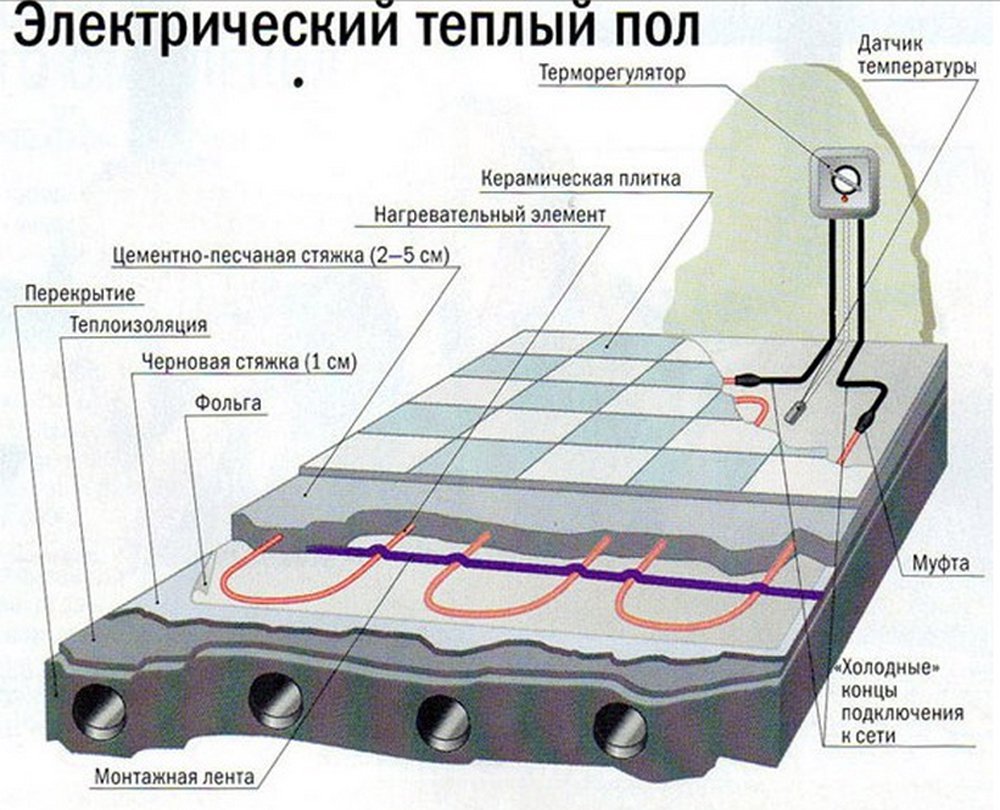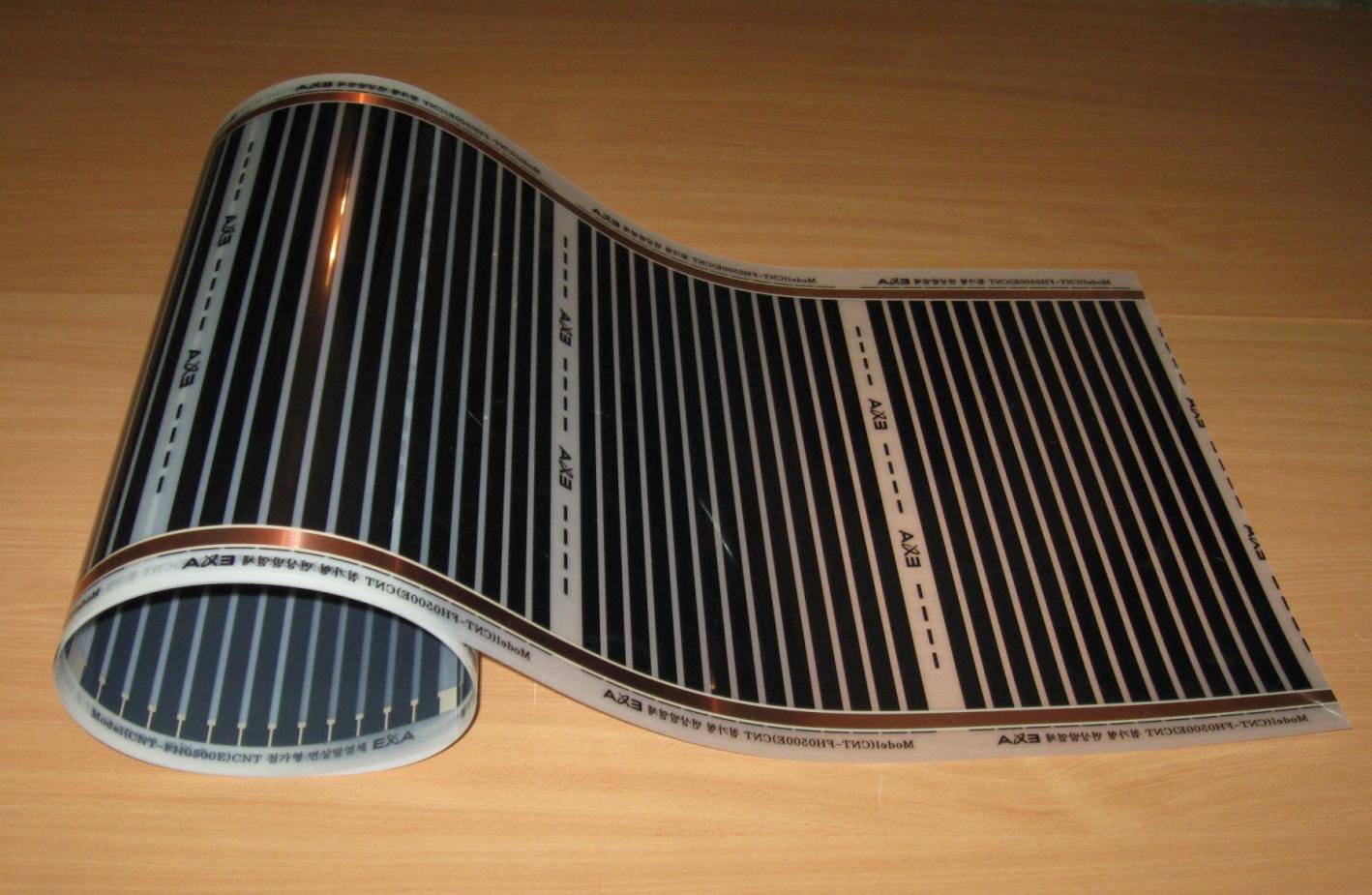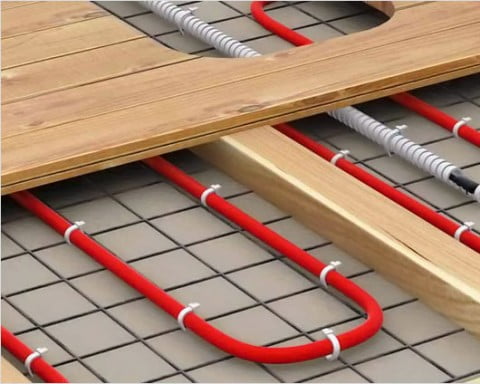Setting up a tile-coated underfloor heating is not difficult, but it needs a lot of attention and a deep approach. That is why it is so important selection of an electric floor for tiles ... Different types of tiles have many perfections, one of which is excellent thermal conductivity. It warms up relatively quickly and retains heat inside for a long period.
Most often, electric floors are used as an addition to an autonomous or centralized system. Installation of such heating can be performed in several versions:
- infrared;
- heating mats;
- cable.
The peculiarity of the systems is due to the used heating element.
This type of underfloor heating is characterized by a greater number of advantages than others, namely:
- noiselessness and invisibility - such a floor does not take up many places, does not create noise, it does not need pumps and boilers;
- increased operational reliability - with such heating, you can not be afraid of leakage;
- uniform heating of the entire space;
- easy temperature setting - the system can be controlled by means of a convenient remote control with a thermostat;
- increased service life, reaching 50 years.
If we talk about the features of the electric floor, it should be noted:
- significant energy consumption - this applies to surfaces that have a large area;
- presence of electromagnetic radiation - like any electrical device, the system creates a small electromagnetic field, which, however, according to SNiP, is safe and harmless.
Distinctive parameters of the electric floor
The features of the operation of the tile are determined in accordance with its significant thermal conductivity. That is, through it, thermal losses in a cold room are limiting, which is compensated by its insulation and installation of an electric floor.

The most important thing when installing electric floors is not to use a screed layer on top. This will minimize the floor thickness and increase the efficiency of the entire system.
The design of this type of floor heating is characterized by the following indicators:
- mechanical resistance - in this case, it must be borne in mind that the heating elements of the floor will be under the constant influence of mechanical stress;
- small inertia - the heating period can be shortened by several methods, for example, by making a programmable temperature controller or increasing the average power.
Film floor
This type of electric floor is the thinnest polymer film with built-in heating elements. This is a fairly economical heating option, since little electrical energy is consumed. Film floor is one of the most heat-saving and efficient systems. However, many experts do not recommend installing an infrared floor under furniture and tiles, because in this case it is quickly damaged. Cork or carpet is best suited for it.

Installation of a film floor has a number of advantages that are quite important. One of them is the ability not to make a cement screed. During the installation process, the infrared film is placed on a heater, laid on a prepared floor surface. It can be cut. This allows you to distribute the system as functionally as possible in those places that need heating. With the help of masking tape, the incisions are isolated. They fix the film on the insulation.
It is imperative to adhere to the fact that the canvas does not overlap. Then the temperature sensor is placed, the connecting wires are connected and led out to the thermostat. A special polyethylene layer is lined on the film, sheets of glass magnesite or drywall are laid out. Thus, it is not long and easy to equip an electric film floor. And this is its important plus.
Cable floor
If you disassemble which is the best electric underfloor heating , then the most optimal type of electric floor is the cable type. It is ideal for loggias, bathrooms, saunas, hallways, baths.
This gender has many positive features:

- Thickness. The heating cable is installed in a screed. According to the manufacturer's instructions, the thickness should be at least 30 - 50 mm. The mats are laid directly under the tiles, which reduces the height of the room by only 0.5 cm.
- The ability to use in rooms with complex layouts. Using a cable makes it possible to create a heating system and at the same time take into account the walls, the placement of furniture, as well as insulate small areas of the room that are uneven.
- Ease of installation. The technology for installing an electric cable floor under the tiles has been greatly simplified. You can easily do it yourself, which requires a minimum of construction tools. The simplest option is a self-regulating cable, for which you do not need to use a thermostat.
Important! When choosing a floor heating system, it is important to consider who will install the electrical cable. If you plan to invite professional builders, it is better to purchase a single-core or two-core heating cable. In other cases, mats should be preferred.
The principle of operation of cable electric floors fully meets the requirements that apply to the effective use of tiles of all types:
- The main features of the layout of tiles. The use of adhesive solutions allows you to make both a strong and elastic connection with the floor surface. As a result, if you follow all the rules for installation and use, the tiles will serve for a long time and retain their initially attractive appearance.
- Excellent heat transfer performance. The system of cable electric floors with tiles makes it possible to ensure operational heating of the surface. This option allows you to keep warm for a long time after the voltage is turned off. In addition, in this situation, there is no overheating of the cable.
- Safe operation. Often in rooms with high humidity, such as balconies, baths, hallways, saunas, and so on, tiles are used. The heating cable has an increased protective level. Correct connection prevents possible electric shock.
- Low cost of the device. This type of floor, powered by electricity, is installed at a lower cost. In case of repair, it will take no more than a week, much still depends on the qualifications of the master.
Heating mats
The thinnest fiberglass mesh, having a thickness of 3 mm, with a fixed cable - these are heat mats. They are available in rolls and are easy to install. After installation, the floor surface can be used after a couple of hours, since tile adhesive is used during the arrangement, and not a concrete screed.

Attention! Before buying, it is necessary to carefully calculate the heating area, since the mats cannot be cut without violating the integrity of the wire.
Heating mats are highly discouraged to lay under stationary appliances or furniture. It is also necessary to take into account the purpose of heating - heating mats will be the main or additional way of heating the room. Accordingly, you can choose a system with the required power - the larger the heating space, the more powerful it should be.
Laying the film floor is much easier than other electrical type systems. The installation steps are as follows:
- preparation of a concrete base (without the use of insulation);
- fixing the structure with adhesive tape;
- installation of a thermal sensor;
- connection of wires;
- even distribution of tile adhesive over the surface;
- laying out the plate.
The nuances of choosing an electric floor for tiles
After all types of systems have been studied, the question arises, how to choose an electric underfloor heating ... The manufacturers of such floors are very different - the Russian Federation, Sweden, South Korea, Norway, Denmark.
The assortment is diverse, from small mats to cables with a heating effect. Systems with a 2-core cable are especially recommended. They emit a minimum of electromagnetic waves. But a single-core floor does not differ in this indicator.
The selection cost is also significant. It should be noted that the cable floor is cheaper than mini-mats by about 1/4. But they have the smallest thickness, respectively, the height of the room does not decrease. In addition, there is no need to lay out a sand-cement screed. However, mini mats do not have a power adjustment.
When arranging a heating floor under a tile, the technology of the device depends on the type of floor. It also affects the amount of work in general. However, in general, they have features that are inherent in all types of electric floors.
First of all, when choosing, you should take into account the power of the floor. Its value is influenced by:
- gender assignment;
- room indicators.
If the floor is installed in a heated and dry room as additional heating, then it is best to opt for a power of 100 - 120 W / m 2 ... When the underfloor heating is placed in rooms with high humidity, a power of more than 150 W / m is needed. 2 ... If the electric floor under the tiles acts as the main heating system, then the power should be even higher.
Ceramic tiles are among those types that do not emit negative toxic substances, which is quite rare for floor coverings. Therefore, an electric floor and ceramic tiles are the perfect combination, which is absolutely justified.
Tiles are often laid out in rooms with high humidity. It can be a bathroom, kitchen, hallway. This flooring material is ...


